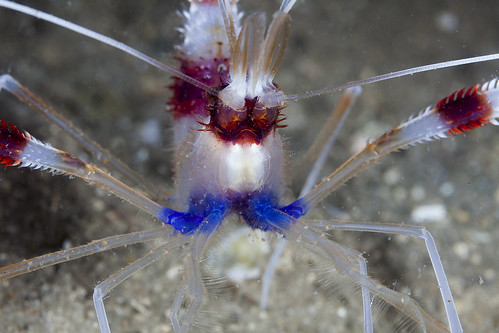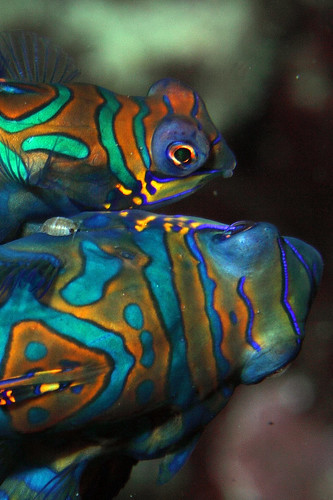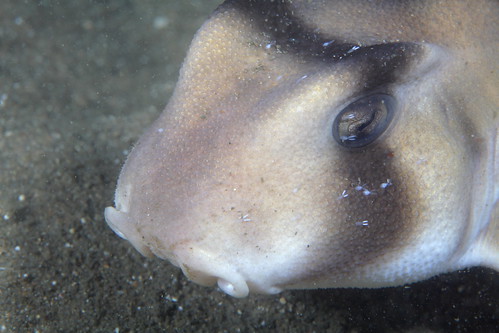Parasites
“You parasite!” is quite an insult. And rightfully so! A parasite is an animal which lives off the bodily substance of another one while the victim is still alive. This is in contrast to a predator, which hunts down and kills the fellow creature it lives on. A big dangerous toothy predator inspires fear in us, but we also respect it and admire its might – just think about these majestic lions or awe-inspiring sharks. But a parasite only evokes disgust. Even when looking only at a fish (otherwise quite alien to us in its mindset) befallen by some parasite, we shudder with revulsion.

Parasites might be freaks, but are by no means freak occurrences. In fact, most animal species are believed to be struggling with several types of parasites. In the warm, biodiverse waters of the tropical and warm-temperate (Sydney) Pacific Ocean, parasites are abound. I have found parasites on many different species of fish, and on sea slugs. And I have frequently observed parasite-cleaning activity: on tropical coral reefs, a cleaner station is a great attraction for the underwater naturalist. Such a station is the home range of a parasite removing fish or shrimp. It’s often a prominent coral head or crevice. Divers can often observe a line of larger fishes waiting to be serviced by these unusually specialized animals. On these cleaning stations, fish which would otherwise try to eat each other or fight for territory become calm and docile. It’s like a bunch of hooligans in a doctor’s office who know that they need to behave to get their treatment! Once a fish is up for cleaning, it sometimes changes body coloration (to signal cleaning readiness – see the image of the Hawaiian goatfish below), and spread their fins and open their mouth. The cleaner wrasses or shrimps then busily sweep over their client’s body, even enter mouths and gill cavities, and munch the parasites they find. It’s a win-win situation (a mutualistic symbiosis): the client fish has its parasites removed, and the wrasse gets a rich meal (yummy! Parasites! Sydney has quite a sophisticated restaurant scene, but I haven’t yet found a place which serves these). After a couple of seconds of such a treatment, the relieved, now parasite-free client fish swims off.

Interestingly, the cleaner wrasses of the tropics are joined by cleaner clingfish on the Australian east coast around Sydney. Clingfish are a family of small fishes somewhat related to gobies, and one species here has evolved to be a parasite remover as well. What environmental or evolutionary-history factors have led to the addition of a new member to the cleaner-guild in our warm-temperate waters I don’t know, but would love to find out. The cleaner clingfish often hide on sponges when not in action. I’ve had them try to clean the skin of my hands, as well as the tropical cleaner wrasses work on my legs – they seem to be quite attracted to my body hair and kept picking on it!

In Malapascua, Philippines, one of my favourite places – ever! – for diving adventures, we divers have the opportunity to see the rare and elusive thresher shark. These large predators of fishes usually stay deeper than a recreational diver can go, and spend much of their lifes in the open ocean. We can observe them in Malapascua because they visit the reef on nearby Monad Shoal to get – you have guessed it, I’m sure – their parasites removed by cleaner wrasses. The parasites pesking the sharks are crustaceans and flat worms. The sharks were found to have parasites in their gills (I’m sure that hurts, even though I don’t have gills myself) and their urethra (Ouch! Yikes!). The spectacular and rarely observed breaching of these amazing sharks is most likely also an effort for parasite removal. When they re-enter the ocean at great speed, the rush of water through their gills unhinges some of the parasitic crustaceans stuck there.

Recent marine biological research (led by Dr. Alexandra Grutter and Prof. Bob Warner) also suggests that pressure from parasites is a significant factor in shaping the life histories of fishes. Many bony fishes (all fishes other than sharks & rays) are small animals to begin with, and start out life very small, as minute larvae. The toll a parasite takes on a larva less than a centimeter long will be significant. In comparison, if a mosquito drinks a few micro-liters of blood from you or me, that might lead to an itch, but is hardly life-threatening. A comparable amount of body fluid taken from a fish or fish larva with only a few grams of body mass will cause a significant problem! That’s why, quite possibly, a lot of fish larvae escape the reef and live in the open ocean (in the pelagic environment), and only settle on the reef after they have reached a certain minimum size. And even for smaller settled fish, like the really sick looking goby above, a single parasite can be a major drain.

Parasites are an important part of the ecological interactions going on underwater. So, if you see a little goby carrying a comparably huge parasite during one of your next dives, I hope you’re not simply creeped out anymore, but find the whole parasitic situation interesting as well!
Check out all of my parasite and cleaning pix here. If you’d like to chat marine biology & dive & shoot pictures underwater with me, join me at the Evolution Photoganza September 2014 in Malapascua, Philippines!

Very cool post. I love finding parasites when I’m going back through my photos of their hosts… although I’m sure the fish and other critters don’t love it one bit 🙂